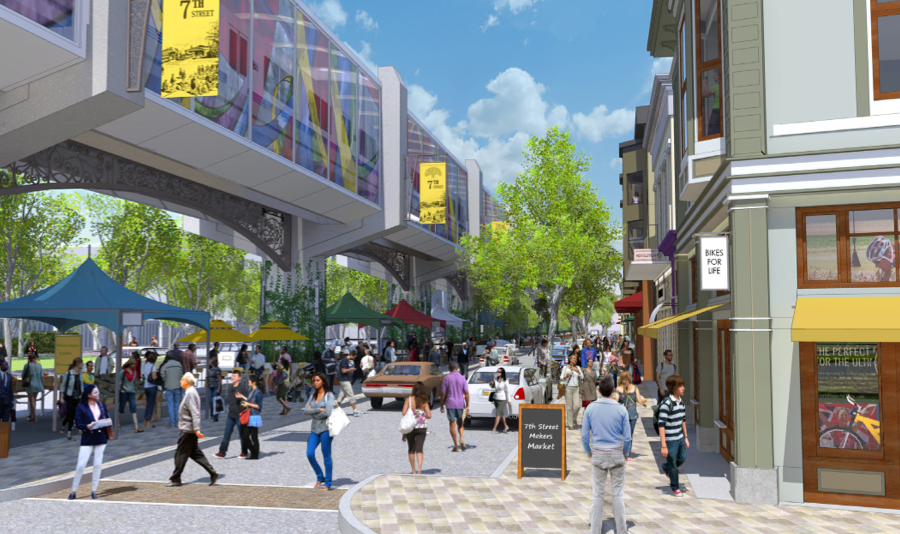Council Approves West Oakland Development Plan
Jul 21, 2014

By Ken A. Epstein
The West Oakland Specific Plan, designed to guide and encourage residential, commercial and industrial development on 1,900 acres of land next to downtown Oakland, was approved at the City Council this week.
Some community members wanted to postpone the decision, protesting against the plan. They are concerned about the ongoing displacement of the West Oakland community. They say the plan lacks teeth, especially a way to maintain and build affordable housing to keep current residents in the city.
On the other side, some West Oakland residents are complaining the approval is a year and half late, jeopardizing the possibility of development projects in the area, especially the Mandela Village plan at the West Oakland BART station.
Council members voted for the plan 7-0. Desley Brooks abstained, arguing the passage should be postponed for a few months until affordable housing provisions could be added to the document. She points to the displacement of the elderly, disabled and people of color that has swept through the city and especially West Oakland in recent years.

“Why is there a rush to adopt a piecemeal plan? A whole lot of things are falling through the cracks,” said Brooks. “ We need to build housing for the people who want to move here and the low-income and middle income people who are already here – to maintain the rich diversity that makes Oakland special.”
According to the city, the plan will result in no displacement of residents and create about 28,000 jobs over the next 10 years.
In the works since 2010, the specific plan looks at land use, economic and market conditions, infrastructure deficiencies, transportation, public safety and security.
The plan will create a blanket West Oakland Environmental Impact Report (EIR) for the area, which means developers, as long as they stay within the plan’s guidelines, will be able to move ahead on projects without dealing with zoning approvals.
The plan focuses on four “Opportunity Sites” to be developed: the Mandela/West Grand area, the San Pablo corridor, the area around the BART station on 7th Street and the area next to the Port of Oakland around 3rd Street. At these sites, transit, housing, light industrial and retail outlets will be developed.
Councilmember Lynette McElhaney, who represents West Oakland, was the primary member of the council advocating for the plan.
She says that opponents are understandably deeply concerned about the gentrification forces that are leading to the displacement of so many low-income and middle-income residents. But their concerns about the plan are unfounded.

“The things people things are afraid of, I don’t find in the plan.” she said.
In addition, McElhaney says some activists are proposing solutions that do not deal with the actual economic forces that are unfolding in West Oakland and throughout the city.
For instance, many groups do not want to build market-rate housing. But the lack of market-rate housing in Oakland is driving up existing rents and home price because people with money want to move here and are willing to pay more.
“More market rate housing removes pressure on existing units,” she said. “In some ways, the thing people fear is producing the thing they are afraid of.”
McElhaney also says that people are unrealistic about development prospects. Developers want to build in San Francisco, but they do not want to build in Oakland, she said. The only one willing to build in the city are Oakland-based developers like Michael Ghielmetti and John Protopappas.
“It would be great to build something, but we’re not building,” she said. “Oakland can’t beg a developer to come to the city right now. The reality is that you can’t get (developers) to come here without incentivizing the development.”
On the other hand, there are speculators who have snapped up property in West Oakland in the hope that Emeryville real estate development will spill into West Oakland, she said, but they will be disappointed.
“That’s not going to happen,” McElhaney said. “This plan very much constrains any residential growth.”
The plan includes the suggestions of local people who want to keep a lot of the area zoned as industrial land for companies that will produce jobs. If industrial land ends up being rezoned for housing, prices will soar, and industrial uses would be forced out, she said.
In summary, she said, “This is a very conservative plan that will not relieve housing congestion” but attempts to strike a balance between commercial, residential and industrial development, as well as maintaining the cultural integrity of the area.